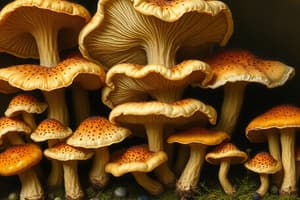Podcast
Questions and Answers
What is the structure of yeasts?
What is the structure of yeasts?
- Multicellular filaments
- Long chains of spores
- Unicellular spheres or ovals (correct)
- Aerial reproductive hyphae
Where are most human pathogens located among fungi?
Where are most human pathogens located among fungi?
- Dimorphic (correct)
- Yeasts
- Aerial reproductive hyphae
- Molds
What factors predispose someone to an opportunistic mycosis?
What factors predispose someone to an opportunistic mycosis?
- Geographical factors, seasonal factors, economic factors, cultural factors
- Psychological factors, social factors, occupational factors, educational factors
- Medical procedures, medical therapies, preexisting conditions, lifestyle factors (correct)
- Genetic factors, environmental factors, dietary factors, age
Why are fungal infections sometimes difficult to treat?
Why are fungal infections sometimes difficult to treat?
How are fungal spores different from bacterial spores?
How are fungal spores different from bacterial spores?
Flashcards are hidden until you start studying
Study Notes
Yeast Structure
- Yeasts are eukaryotic microorganisms, typically 3-5 μm in diameter
- Have a cell wall composed of chitin, glucans, and mannoproteins
- Possess a true nucleus, mitochondria, and other membrane-bound organelles
Human Pathogens among Fungi
- Most human pathogens are found among the Ascomycota and Basidiomycota phyla
- Examples include Candida, Aspergillus, Cryptococcus, and Histoplasma
Opportunistic Mycosis Predisposing Factors
- Weakened immune system due to diseases like HIV/AIDS, cancer, or taking immunosuppressive drugs
- Prolonged use of antibiotics, which can disrupt normal microbial flora
- Invasive medical procedures, such as IV lines or surgical wounds
- Skin or mucosal damage, providing a portal of entry for fungi
Difficulty in Treating Fungal Infections
- Fungal cells have a similar structure to human cells, making it difficult to develop targeted treatments
- Fungi can develop resistance to antifungal medications
- Fungal infections often present with non-specific symptoms, making diagnosis challenging
Fungal Spores vs. Bacterial Spores
- Fungal spores are often more resistant to environmental stressors, such as heat, radiation, and chemicals
- Fungal spores can remain dormant for extended periods, allowing them to survive hostile environments
- Bacterial spores are typically more sensitive to heat and radiation, but can survive longer periods of dryness and nutrient deprivation
Studying That Suits You
Use AI to generate personalized quizzes and flashcards to suit your learning preferences.




